2023 Indigenous Pride Month events
An interview with U.S. 4th Congressional District Representative Val Hoyle
By GARY CARL/for The Herald — It was a picture-perfect day, on Monday April 10th 2023, when Lynda & I rolled into Congresswoman Val Hoyle’s office in the Longworth Building in Washington D.C. for an official visit to our Nation’s Capital. Lynda had previously scheduled our visit and we were met by Nicole Gelser, a […]
The post An interview with U.S. 4th Congressional District Representative Val Hoyle appeared first on Highway 58 Herald.
Why are we still mismanaging beavers?
A surge in efforts to find ways to co-exist with beavers continues to be opposed by ag lobby and other landowners

Habitat helper: For all the good they do, beavers often get the short end of the stick. Photo: Wikimedia Commons
By K.C. Mehaffey. May 25, 2023. Recognition that American beavers are a vital and often missing component of riverine habitats is growing nationwide, especially in the Pacific Northwest.
Nearly wiped out across the West a century ago, beavers have spent recent decades regarded as a nuisance animal.
Now, their reputation as a keystone species is slowly taking hold.
The dams they create, for free, offer many of the same benefits as costly rehabilitation projects. Their work has been shown to expand floodplains and wetlands, recharge groundwater, provide higher summer flows, improve water quality, create healthy habitat for salmon and encourage a greater diversity of plants and animals.
The natural water storage they create slows the runoff process, keeps freshwater habitat cooler later into the summer and helps counter the impacts of drought.
And as wildfires become larger and more intense with climate change, beaver ponds have been shown to provide firebreaks and offer refuge for aquatic and land animals.
But environmental groups say policy makers in Oregon and Washington—where beavers continue to be managed as furbearers, nuisance animals and even predators—have been slow to respond.
Oregon—the Beaver State—allows unlimited killing of beavers, and has no mechanisms in place to track how many are taken each year. State agencies have no authority to manage them on private land, and do not know how many beavers there are or where they’re causing problems.
In Washington, despite a pilot program that helps relocate nuisance animals, beaver enthusiasts say not enough effort has gone into helping private landowners learn to live with them.
With the pilot program about to become permanent, objections are being raised that trappers are allowed to take relocated beavers.
And a major agricultural lobbying group remains opposed to legislation that would make it harder for farmers and private landowners to simply slaughter beaver populations where they find them.
All of this could be about to change—but will it?
Proposed legal protections
In Oregon and Washington, proposals to provide beavers with greater protections are afoot.
Washington Department of Fish and Wildlife managers say that making the state’s relocation program permanent could begin as soon as this year. They also point to an opportunity to add beavers as a “species of greater conservation need” in the agency’s statewide wildlife action plan.
In the Oregon Legislature this session, a bill to remove the “predator” status of beavers passed the House in April and won the support of the Senate Committee on Natural Resources in May. House Bill 3464A is waiting to be heard by the Senate, but is among hundreds of bills stalled by the Republican walkout, now in its third week.

Beaver backer: Rep. Pam Marsh Photo: Oregon State Legislature
Beaver supporters say provisions in the bill are small but important measures that can help prevent the indiscriminant killing of beavers and help landowners learn to live with North America’s largest rodent.
Rep. Pam Marsh (D-Ashland)—the bill’s primary sponsor and chair of the House Committee on Climate, Energy and Environment—says it’s going to take time for beavers in Oregon to be seen as friends instead of foes.
Her bill, she says, is the first step.
Removing its “predator” status would move management of beavers from the Oregon Department of Agriculture to the Oregon Department of Fish and Wildlife, where they can be overseen as wildlife instead of agricultural pests.
Landowners could still kill them on their own property, but most people would need a permit to do so.
After introducing the bill—and before the walkout—Marsh worked with Republicans in her committee and agreed to amended language to gain more support. Under the amended bill, landowners with beavers causing damage that imminently threatens infrastructure or agricultural crops could bypass the permit, and owners of small forestland are exempt.
But, if the bill becomes law, everyone would have to report the beavers they kill to the state, giving ODFW an opportunity to estimate out how many beavers are in the state, understand where and how they’re causing problems and provide landowners with options other than killing them.
Marsh believes public support for beavers in Oregon is growing. She’s introduced bills to help protect beavers in the past but they didn’t go anywhere.
“We just heard increasing voices across the state for stepping up for beavers,” says Marsh. “We’re seeing beaver-affinity groups, and increasingly seeing landowners who are raving about the results” of allowing beavers to reclaim portions of their property.
Marsh admits beavers can quickly damage property if they’re not properly directed.
“When you know how to work with them, there’s a tremendous capacity to store water and to keep people safe during wildfires,” she says.
Broad support for beavers
In committee hearings, many people testified in support of Marsh’s bill. In the Senate Natural Resources Committee, with the added amendments, only one person out of 48 people testified against it.
Marsh is particularly compelled by on-the-ground stories from people who decided to work with beavers on their property instead of trying to get rid of them.
Among them: Kaitlin Lovell, owner of a 20-acre farm near Colton, Ore., who testified before the Senate committee on May 10.
“Most beaver conflicts you can find a solution for.” —Jakob Shockey, Project Beaver
Lovell says when she decided to encourage beavers to take over about five acres of her land, she was expecting some of the ecological improvements that resulted.
“What we didn’t expect was the economic benefits,” she told the committee.
Lovell testified that her drinking well no longer goes dry. Her primary pasture stays green much later, allowing her to feed stock animals late into the summer without having to supplement their pasture with hay.
And when she evacuated her land in 2020 when the Riverside Fire ranged five miles away, she went to her beaver pond to take a picture of her farm that was threatened by wildfire. She said trees were breaking on her property from the 70 mph winds, and the sky was orange from the nearby blaze.
“In the beaver ponds, it was as if somebody put a glass dome over the ponds,” she said. “It was 10 degrees colder, and it was still. There was no wind. The trees were barely registering, and in that moment, I realized that there’s a lot more happening in these beaver ponds, especially during wildfires, than we’ve even begun to investigate.”
Lovell says the livestock they left behind in the haste of evacuation found refuge there. And the wildland firefighters who used the farm as the entryway to fight the fire identified the ponds as a backup water supply.
“That’s the climate resilience that we really didn’t see and anticipate,” she said.
Farmers: “Not so fast”
Despite growing support for beavers, and compromises made in Marsh’s HB 3464A, the Oregon Farm Bureau remains opposed to it.
Lauren Poor, the farm bureau’s vice president of government and legal affairs, told the Senate committee the bill would create an unnecessary and complicated system of managing beavers for private agricultural land owners, who can now kill beavers without a permit, and without reporting it.

Lauren Poor. Photo: Oregon Farm Bureau
Poor said the bill doesn’t require permits for small forestland owners, but farmers with beaver problems must be facing an imminent threat to infrastructure or crops to bypass the permit system.
Her testimony was the lone voice of opposition to the amended bill.
The Oregon Department of Fish and Wildlife took a neutral stance.
Brian Wolfer, acting wildlife division administrator for ODFW, says he’s explained to thousands of landowners who have problems with other furbearers that kill permits are really a short-term solution.
“When wildlife is on someone’s property, there are conditions that are favorable to them,” he says.
Removing one animal does not remove whatever is attracting the animal, so he works to educate landowners about coexistence strategies.
Beaver control
Jakob Shockey has spent years educating landowners across Oregon about how to coexist with beavers.
Shockey is executive director of the Jacksonville, Ore.-based nonprofit Project Beaver (formerly The Beaver Coalition) and owner of the wildlife control business Beaver State Wildlife Solutions.
“I’ve managed to make a full-time job out of helping the monkeys outsmart the rodents,” Shockey told the House Committee on Climate, Energy and Environment in March.

Jakob Shockey. Photo: Project Beaver
Shockey told the committee about tools he uses to help growers and other landowners benefit from beavers without the damage that comes with them.
He says pond levelers work like the drain in a bathtub that can be set at any level to prevent the flooding of crops; electric fences have been highly successful at keeping beavers away from orchards; and methods to cage off irrigation culverts prevent them from getting blocked.
“We can come up with some pretty crafty things. Most beaver conflicts you can find a solution for,” says Shockey.
Changing the “predatory” status of beavers would also remove language that labels them as agricultural pests, says Shockey.
“A lot of folks feel like, if they have a pest species on their land, in order to be good stewards of that land they have to get rid of that pest species,” he says, adding that the label sends a signal to landowners that isn’t helpful. “Most folks I end up working with didn’t have any idea that another solution was available.”
Shockey says that landowners who get caught in the endless treadmill of trapping beavers to get rid of them instead of finding a permanent solution to live with them end up impacting neighbors who would benefit from them, too.
“Beavers are territorial, and they mate for life. If you remove one, another family will move in, so you’re going to be depopulating the surrounding region of beavers,” he explains.
Shockey believes the top priority in beaver management should be helping people learn to live with them in the places they choose to repopulate.
“The fact that in the House they were able to work together and get bipartisan support [for HB 3464A], I was just tickled. It feels like the bill we’ve all been hoping for for the last decade.”
Shockey hopes the Oregon Senate can meet and vote on the bill before this year’s legislative session ends.
Washington’s 69,000 beavers
In Washington, the state legislature recognized the vast ecological benefits of beavers more than a decade ago, and outlined their benefits in a 2012 law that directed the Washington Department of Fish and Wildlife to authorize beaver relocation and work in partnership with agencies, tribes and nonprofit groups.
The program was expanded in 2017.
“I think the habitat division [of WDFW] is quite aware of the ecosystem benefits of beavers, and as far as I know they are moving ahead and working with others to help them,” says Washington Fish and Wildlife Commissioner Melanie Rowland.
But, Rowland notes, the beaver’s status as an unclassified species still allows unlimited trapping for five months of the year.
And while on paper WDFW is supposed to encourage landowners to coexist with beavers, she’s not sure how far that goes in practice.
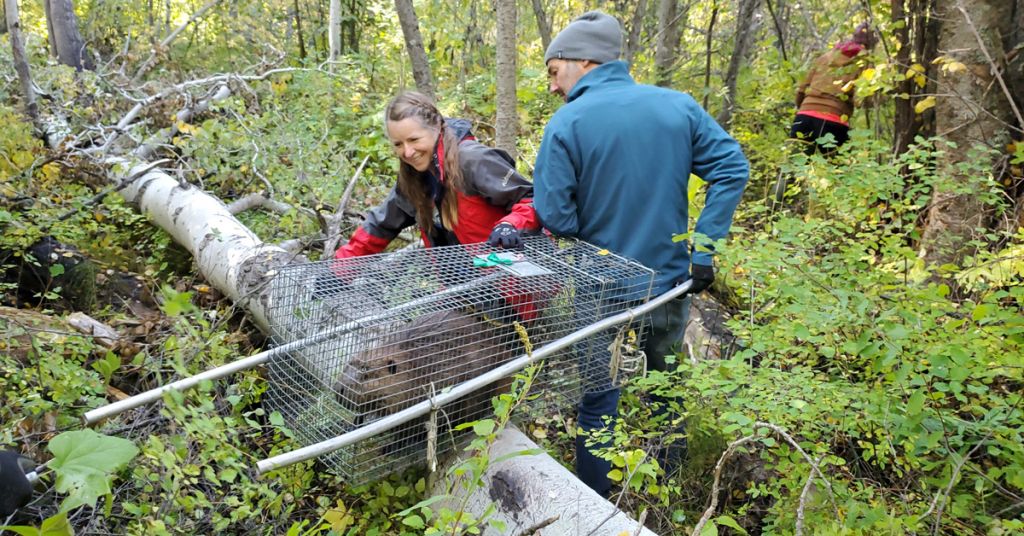
Gnawing issue: Washington’s program of relocating beavers has earned mixed reviews. Photo: Methow Beaver Project
Last year, Rowland asked Washington Department of Fish and Wildlife staff for a briefing on its beaver management. Her main goals were to find ways to support landowners with nonlethal solutions when they have a problem beaver, and to evaluate the impacts of trapping on the state’s relocation program.
“You spend all this time and money and energy relocating a beaver—which is not an easy thing—and then the law says anybody who wants to can go out and kill that beaver. That is the first thing that should go,” she says. “Beavers that have been relocated shouldn’t be trapped.”
But her idea for a temporary moratorium on trapping received significant pushback—some of it from fellow commissioners.
During a December 2022 briefing, WDFW Wildlife Program Director Eric Gardner said that an estimated 69,000 beavers live in Washington, where they’re classified as furbearers.
He said about 500 to 700 trapping licenses for beavers are sold annually, but only about 110 license holders report trapping beavers.
Gardner outlined the harvest of beavers since 1984, which reached a peak of about 10,000 beavers trapped in 1986.
He said the rates of trapping fluctuated almost solely due to the price in pelts until a decline began in 2000, when body-gripping traps were banned in Washington.
In 2021, 714 beavers were taken by trappers in Washington.
Adding in the number of beavers killed by wildlife control operators or special trapping permits for problem animals, a total of 1,782 beavers were taken that year, said Gardner.
Five months after the briefing, Rowland says she believes the way beavers are managed in Washington is inconsistent, with different provisions for the animal as furbearers, as nuisance animals and for conservation purposes.
Given the importance of beavers to the ecosystem, she’d like to see more protections in place, especially for beavers that are relocated.
“It’s too long. This has been known and stated by the legislature since 2012, and we still have not changed anything about the trapping of beavers,” she says.
Rowland sees several avenues to help strengthen beaver policies, including in the next update to the state Game Management Plan, and a proposed Commission Conservation Policy that would point to the conservation of Washington’s biodiversity as WDFW’s top priority. It states, “This responsibility is becoming increasingly difficult with the amplified effects of climate change, growing human population and development, resulting in fragmented or lost habitat, invasive species and increasing disease.”
Rowland says that beavers can be key to conserving biodiversity in riparian habitats, but that state policies have changed at a “glacial” pace.
“There’s no question there’s lots of activity and recognition of the habitat value of having beavers,” she says. “In terms of moving people—the hunters and trappers and landowners that just think of beavers as vermin, nuisances or pelts—I have no idea if that’s changing.”
To Shockey, the public’s perception of beavers changes one landowner at a time. He says even though Oregon is still working to legally change the status of beavers, he thinks the Beaver State is well positioned to lead the Northern Hemisphere in developing a healthier relationship with nature’s greatest engineers.
With help from agencies and Washington organizations, Project Beaver developed a manual for best management practices to help people coexist with them, which people in Europe are looking to adopt, he says.
Once people stop fighting with beavers and start working with them, says Shockey, they’re sold.
 As a supporter of Columbia Insight‘s recognition of Earth Day, the Gorge Rebuild-It Center has sponsored this story.
As a supporter of Columbia Insight‘s recognition of Earth Day, the Gorge Rebuild-It Center has sponsored this story.
The post Why are we still mismanaging beavers? appeared first on Columbia Insight.
Why are we still mismanaging beavers? was first posted on May 25, 2023 at 7:25 am.
©2022 Based in Hood River, Oregon, Columbia Insight’s mission is to publish original, balanced journalism about environmental issues affecting the Pacific Northwest. Columbia Insight is a fully independent, registered nonprofit organization. To support environmental journalism “donate here” to Columbia Insight.
Indigenous communities across Oregon raise awareness for missing and murdered relatives
Data center on Columbia River would nearly double town’s energy consumption
The Bonneville Power Administration has confirmed Cascade Locks mayor’s concerns about proposed new construction

More, please: Located five miles downriver from Cascade Locks, Bonneville Dam generates electricity to power approximately 900,000 homes. Photo: Kevin Wingert/BPA
By Nathan Gilles, May 3, 2023. In March, Columbia Insight published a lengthy investigative story on a new $100 million data center proposed to be built by a startup company called Roundhouse in the small Columbia River Gorge town of Cascade Locks, Ore. Our reporting addressed many locals’ concerns about the company, its CEO Stephen D. King and its proposed data center.
Among other issues, Columbia Insight discovered that King owed over $1 million to former business partners due a previous troubled business deal in the Gorge.
What Columbia Insight was unable investigate at the time were concerns residents said they had about the data center’s expected energy usage, and statements made by King that local electricity rates would not increase due to the data center’s added electric load.
The most noteworthy Cascade Locks resident to dispute King’s claims has been Cascade Locks Mayor Cathy Fallon.
Fallon has said publicly that the new data center will both raise the cost of electricity for the City of Cascade of Locks and make the city contractually obligated to continue paying that higher cost even if the data center should close its doors and stop consuming electricity.
King has publicly taken issue with these claims.
However, representatives from Bonneville Power Administration (BPA), which provides power to the City of Cascade Locks, have now confirmed to Columbia Insight that BPA does plan to charge the city a higher rate for its electricity due in part to the new data center’s power usage.
BPA representatives also confirmed that as a condition of its contract with BPA, the city will be responsible—at least in the short term—for some, though not all, of the increased costs associated with the data center should the data center close.
Complicating the issue is the fact that even without the data center online and consuming electricity, BPA will be raising the city’s power rates in the upcoming fiscal year starting in October 2023.
According to a recent City of Cascade Locks memo obtained by Columbia Insight, these new increased rates are expected to cost the city an additional $570,000 a year.
And BPA isn’t the only utility raising its rates. Pacific Power and Portland General Electric are also increasing their rates.
However, $570,000 in additional costs pales in comparison to the nearly $5 million in additional costs the City of Cascade Locks will be expected to pay when the data center is fully online, according to estimates made by BPA.
Yet how and if the city’s many electricity customers, including local households, could end up paying for this increase is uncertain.
What is certain is the city is currently exploring the idea of raising its rates on its customers to cover this year’s rate increase with BPA.
What’s also certain is the data center will significantly increase the amount of power consumed in Cascade Locks.
Roughly double power consumption … for starters
The City of Cascade Locks currently provides roughly 4.5 megawatts (MW) of electricity a month to its local businesses and households. In winter, as temperatures drop and furnaces turn on, that number can reach as high as 7 MW, according to numbers provided by the City of Cascade Locks.
When complete, the data center is expected to consume roughly twice as much electricity as the town’s current households and businesses combined.
This power won’t come online all at once, but in phases.
In the first phase, Roundhouse will operate a data center out of the Flex 6 building, an existing Port of Cascade Locks building that now lies empty.
Roundhouse is expected to use 3.6 to 4 MW of electricity a month at Flex 6, according to previous statements made by King.
For phase two of the data center, Roundhouse hopes to build a second facility on a nearby 10-acre empty lot. This facility is expected to need an additional 7.2 MW a month, for a total energy usage of about 10-11 MW, according to previous statements made by King.

Center of attention: The proposed data center would be built in the Flex 6 Building in Cascade Locks, which is currently unoccupied. Photo: Jurgenhessphotography
But Roundhouse’s power consumption might not end there.
At an Oct. 27, 2022, Port of Cascade Locks commission meeting, King told the Port commissioners if the two facilities proved successful, Roundhouse would consider building a third facility for its data center, raising the company’s total electricity consumption to 25-30 MW, according to meeting minutes.
King also told Port commissioners that BPA’s power, which he said was priced at “50% of what it’s worth,” was one major reason Roundhouse was pursuing a data center in the Columbia River Gorge, according to a video recording of the meeting.
The source of this electricity, hydropower, will also help the data center meet industry standards to quality as a “green” data center, according to statements made by King during a March 2023 interview with Columbia Insight.
King did not respond to email and text requests for an interview for this story.
James Longacre, Roundhouse’s chief operating officer and chief engineer, also did not respond to Columbia Insight’s request for an interview.
Mayor vs. King
King has said the data center’s use of electricity would benefit the City of Cascade Locks’ budget.On Feb. 2, the day before Roundhouse and the Port signed a Memorandum of Understanding, King presented a document to the Port that claimed Roundhouse’s direct purchase of electricity from the City of Cascade Locks would increase the city’s power revenues by $1.5 million annually.
Fallon says she has no idea if this number is accurate or not.
“The bottom line is anything that Stephen King says you can’t take it for the truth,” says Fallon. “Some of what he says could be true, but you don’t know because he lacks credibility.”
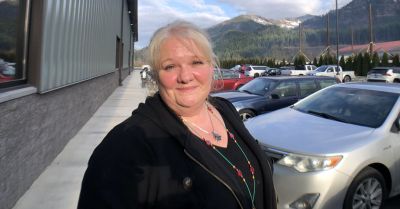
Looking at numbers: Cascade Locks Mayor Cathy Fallon. Photo: Nathan Gilles
Fallon says King has frequently not answered her questions and has made contradictory statements. Several of these statements she says have to do with the data center’s projected water usage.
As Columbia Insight reported in March, King had originally proposed running the data center using a system that would use “no water,” but later changed the data center’s design to a system that uses “four people’s worth of water” per year, according to statements made by King.
Fallon says King’s past behavior coupled with the data center’s projected power usage makes her wary of the new data center.
“The whole thing is a gamble,” Fallon told Columbia Insight. “I don’t want Cascade Locks holding the bag.”
Fallon has publicly challenged King’s statements about the data center’s power usage.
The two faced off on March 15 when the Port of Cascade Locks and Roundhouse held an open house to discuss the new data center.
The open house was held at the empty Flex 6 building, the proposed site of data center’s first phase.
Flex 6 was built by the Port for a business called The Renewal Workshop, a clothing recycling company. The Renewal Workshop, however, ran into financial problems, leaving Cascade Locks in April 2022 after the company was acquired by a Dutch company.
At the open house, Fallon told the crowd that leasing Flex 6 to a data center involved an even larger risk than having a manufacturing business like the Renewal Project occupy the space.
“The Renewal Project that came in, their power usage wasn’t very much at all,” said Fallon, addressing the crowd, King and members of Roundhouse. “It’s a big difference if a data center comes in and fails, because BPA says our power increases [with the new data center] and once it increases we don’t get to say to the BPA ‘well we’re not using that much power anymore, so we want our old rates.’ It doesn’t work that way.”
King was quick with a rebuttal.
“Your paying rates have nothing to do with our data center,” said King.
“It’s going up. Rates are going up,’” Fallon responded.
“Not due to our usage,” said King. “However, we have said if our particular usage goes up we would cover that. Frankly, I’m not worried because it’s not correct.”
So, who is right?
It depends on how one defines “rates.”
The city’s rates
BPA sells power to the City of Cascade Locks, which operates the local public utility district. The city then sells that electricity to its electricity consumers, including households and businesses.
BPA sells electricity to the city at what is, in effect, a wholesale rate. The city then sells this electricity to its customers at what is, in effect, a retail rate.
Fallon says the “rates” she was referring to are the rates BPA sets for the City of Cascade Locks, not the rates households and businesses pay for their electricity.
The data center’s added electric load means the BPA will charge the City of Cascade Locks a higher rate for its electricity.
The rates that the city charges its customers once it has that electricity might or might not go up due to the data center depending on where the city sets its rates. Fallon says the city is currently taking steps to make sure the rates at which it sells electricity remain affordable.
The City of Cascade Locks, at Fallon’s request, is currently working with an attorney specializing in data centers to ensure that Roundhouse—and not the city’s other electric customers—pay for any cost increases associated with the data center.
“I’ve spoken with other city governments,” says Fallon, “and there are ways that we can structure our rates so that Roundhouse pays for [the cost of] their load and those costs aren’t passed on to the rest of Cascade Locks.”
While Cascade Locks currently charges most households and businesses a flat rate for their electricity, the city is currently developing a special “negotiated rate” for Roundhouse, according to Jordon Bennett, city administrator for the City of Cascade Locks.
“We have never had anything close to this before,” says Bennett. “We have one business [Roundhouse] coming in and essentially asking for double the amount of power the rest of the city uses. They are such a large utility we are looking at doing a negotiated rate.”
BPA rates and load study
By contrast, the rates BPA charges the city are projected to increase.
BPA’s rates are projected to increase starting in October without the data center online, according to the recent City of Cascade Locks memo. But they’re also projected to increase in the years ahead due in part to the data center, according to an electric load study conducted by BPA and obtained by Columbia Insight.
BPA verified the authenticity of the document.
The load study includes several projected future rate scenarios that calculate what the city is likely to pay BPA in the future depending on how much electricity it consumes.
The load study includes three scenarios with the data center’s electric load online and one with it offline.
The offline scenario is called the “Base Case” because it sets a baseline for the other scenarios. The base-case scenario is projected for October 2024.
In the base-case scenario, BPA is expected to charge the City of Cascade Locks $46.58 per megawatt hour (MWh) for its “Total Effective Power Rate,” according to BPA’s load study.
However, with both phases of the data center online, BPA plans to increase the city’s total effective power rate to $57 per MWh, a rate increase of 22.35% above the October 2024 base-case scenario.
Kevin Farleigh, account executive at BPA, confirmed that this increase of 22% is due in part to the data center’s energy usage.
“Yes, they [the data center] would raise the rates at which the city is buying power from us [BPA] by that 22%,” says Farleigh, referring to the load study.
This scenario is projected to start as early as 2025, according to the load study, though Farleigh says 2026 is probably a more accurate date for the rate increase to begin.
Farleigh says any actual rate increase in the future assumes rates stay comparable to what BPA is projecting, adding that these rates could change.
“That forecast could either be too high or too low,” says Farleigh.
“On the hook”
BPA Senior Spokesperson Doug Johnson confirmed the data center’s added electric load will mean BPA will not only charge the City of Cascade Locks a higher rate for its electricity, but also that the city will be required to continue paying BPA at that higher rate even if data center closes.
In practice, this also means the city would be required to cover at least some of costs of the missing electricity consumption should the data center go out of business and stop consuming electricity, according to Johnson.
However, Johnson says, the city wouldn’t have to pay the full amount for data center’s missing load because BPA would sell the unused electricity to other users on the electric grid.
In this scenario, BPA would credit the city for the sold electricity.
Only it’s a little more complicated than that.
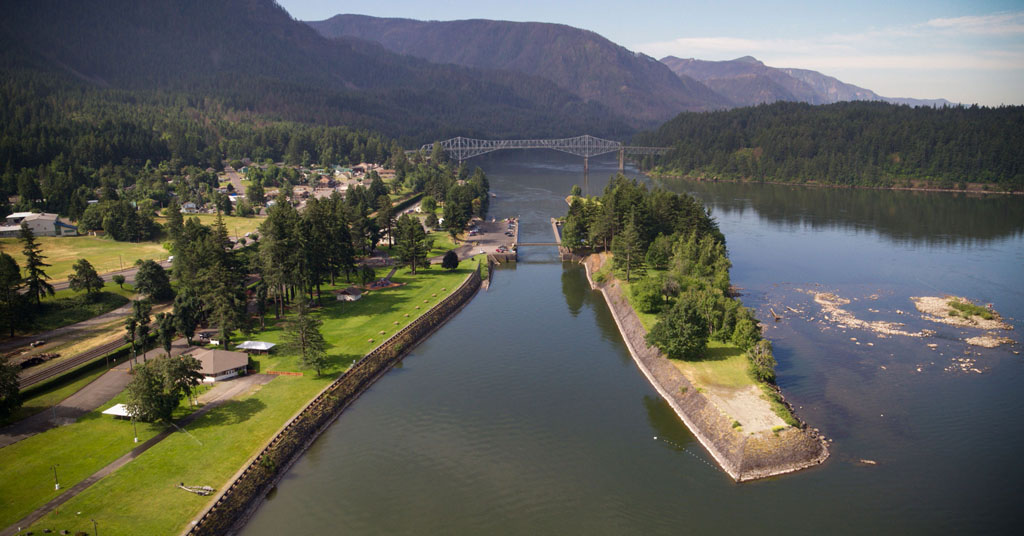
Mighty small: About 1,400 people live in Cascade Locks. Photo: City of Cascade Locks
BPA will credit an account regardless of whether it sells the electricity or not. However, BPA is unlikely to credit the full amount owed, according to both Johnson and Farleigh.
Both men confirmed that BPA typically credits unused electricity at a rate that is lower than the rate the original user would have bought the electricity for if the load were still being used. This means should the data center go away, the City of Cascade Locks would most likely owe BPA for some of the data center’s unused electricity.
“Under the current rate structure,” says Johnson, “it [current credit pricing] certainly wouldn’t make them [the City of Cascade Locks] whole [out of debt with BPA], but it would certainly provide a little bit of relief if the [data center’s electric] load evaporated.”
What’s more, Johnson says, if the data center were to go away the city wouldn’t be responsible for these costs indefinitely. That’s because BPA’s contracts are organized in two-year periods.
“If it [the data center and its load] goes away,” says Johnson, “you’re only on the hook for that amount for whatever that proportion of the two years for which the rates are set and then it starts over again.”
The city could also renegotiate its rates with BPA within its two-year contract. Though Johnson says the renegotiation process takes time.
Total costs
Cascade Locks is also projected to have a much larger total electricity bill with the data center online.
The 2024 base-case scenario (in which the data center is not yet online) estimates the city’s “Total Power Charges” will be roughly $1.8 million a year, according to the load study.
With both phases of the data center online in 2025, the city’ total power charges will be roughly $6.6 million a year, according to the load study.
The load study also includes two scenarios in which the data center’s power is phased in during 2024 and 2025. Under these scenarios, BPA plans to sell the city electricity at reduced rates.
However, even with these reduced rates in 2024 and 2025, the city is projected to pay as much as $2.8 and $4.8 million respectively, according to the load study.
Cascade Locks City Administrator Jordon Bennett says these large bills require “responsible” planning on the city’s part.
“Our stance is if it [the data center] happens, great,” says Bennett. “But we as an electrical utility, we are required to sell them power and we are going to do it in a way that makes sure we have enough [electricity] to power the whole city and they’re not taking it all and we’re not left holding the bag.”
Depending on the scenario, says Bennett, the city might or might not have the money in reserve to pay BPA what it owes should the data center go out of business.
“We do have money in reserve, though not in that amount,” says Bennett, referring to projections in BPA’s load study.
If the city were to come up short, Bennett says it would consider raising rates on its other electricity customers to cover the bill.
However, Bennett says regardless of the data center’s projected energy usage, the city will be raising its electric rates to cover the $570,000 in additional costs BPA is expected to charge the city for electricity in the upcoming fiscal year.
And this is what the city is currently exploring doing, according to the recent memo, which was written by Bennett.
The memo reads: “To ensure the City Light department can stay solvent we must look at rate changes.” Asked to explain if this language meant the city was going to raise rates on its customers, Bennett was straightforward.
“Yes, we’re going to have to [raise rates],” says Bennett. “How exactly that math is going to pencil out, I don’t know. But that’s kind of how it works. We have to pass it on [costs].
New substation, “overgrown paperweight”
But there’s another problem associated with the data center’s projected energy consumption: Cascade Locks currently doesn’t have the electric infrastructure to support both phases of the project.
The city currently has the infrastructure to accommodate Roundhouse’s 4 MW usage at Flex 6, but it wouldn’t be able to accommodate the full 11 MW—let alone 25-30 MW—without a new substation.
“There is no way they [Roundhouse] can do what they are calling their phase two without an electrical system update,” says Bennett. “There is no way.”
The city’s current substation, called the Pyramid substation, can accommodate about 14 MW.
With the Flex 6 building’s 4 MW online, the substation will run at roughly 70% capacity, according to Bennett.
Bennett says the city is hoping to add an additional 35 MW by building a new substation.
The new substation plan was proposed in 2017 when the Eagle Creek Fire raised concerns that the city’s electric infrastructure was vulnerable to wildfires, according to Bennett.
The city has since acquired a $2.4 million grant from the U.S. Economic Development Administration to buy the new substation and purchase the land for the new substation from BPA.
But as part of its deal with BPA, the City of Cascade Locks is required to buy a smaller 6 MW substation in order to buy the land for the larger 35 MW substation. This smaller 6 MW substation won’t be used, according to Bennett.
“It’s essentially an overgrown paperweight at this point. I mean it works, but at 6 megawatts it doesn’t do much,” says Bennett.
Bennett says the deal with BPA isn’t finalized yet.
Possible limits to growth
Brad Lorang, vice president of the Port commission and a former mayor of Cascade Locks, says he sees another potential downside to the data center’s heavy power usage.
Lorang says having one company consuming such a large amount of electricity could limit local economic development by limiting the Port’s ability to attract other businesses, especially if Roundhouse builds its facility out to 25-30 MW.
“I do not want us to get into a situation where some other business would want to come along, and we’re already maxed out on our ability to provide power,” says Lorang.
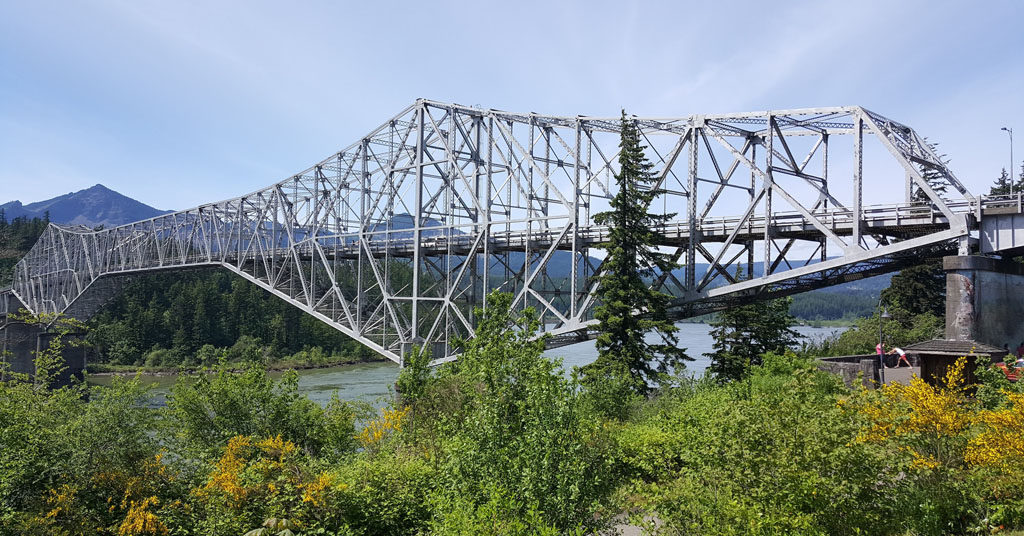
Columbia crossing: The Bridge of the Gods is owned and operated by the Port of Cascade Locks. Photo: Di Manickam/Unsplash
In February, when the five-member Port of Cascade Locks Commission signed a memorandum of understanding with Roundhouse to approve the data center, Lorang, who has been a vocal critic of the data center, cast the lone dissenting vote.
The MOU was expected to lead to Roundhouse signing a 25-year lease with the Port. The signing of the lease is behind schedule, according to Lorang.
Roundhouse was expected to occupy the Flex 6 building starting in April. That did not happen. Lorang says the company’s move-in date was moved to May 1, but that hasn’t happened either.
Lorang says the Port has had other offers to both lease and buy Flex 6 from the Port, which he says would help lower the Port’s debt burden.
Lying empty, Flex 6 has cost the Port roughly $300,000 in accrued interest on the $6 million loan the Port took out to build the facility, according to Lorang.
But Lorang says he’s concerned that the data center could limit local development in another way as well. Lorang says local economic development is limited due to the town’s small size and the Columbia River Gorge National Scenic Area that surrounds it.
He says one of his biggest concerns with the proposed deal with Roundhouse is the company’s plans to build out the nearby 10-acre lot, which Lorang says not only ties up that land but would discourage other types of development, such as a resort, which he says would provide a greater positive economic impact for Cascade Locks than a data center.
“It’s beautiful property,” says Lorang. “It’s right on the river. In my mind, a data center is not the best use for that property. And we really have one shot at this, because once you start putting in a large industrial [data center] it will become hard to attract other types of businesses. A resort is not going to want to locate next to a huge warehouse.”
Lorang says he also has his concerns about both King and Roundhouse. While many members of Roundhouse have experience with data centers, King does not.
Lorang says this fact and information revealed by Columbia Insight about King’s past business dealings have made him even more critical of the proposed data center.
King’s past
As Columbia Insight reported in March, King ended up owing over $1 million to former business partners when King failed to complete a previous project for a proposed aquaponics facility in Hood River County. This failed business deal led to legal action being taken against King and a separate investigation by the State of Oregon into potential fraud and violations of securities laws on King’s part.
Columbia Insight has since obtained through a public records request a partially redacted investigation memorandum from the Oregon Department of Consumer and Business Services Division of Financial Regulation concerning King and the Hood River project.
The memorandum confirms many details in Columbia Insight’s reporting, including how a single investor lost over $880,000 to King when King attempted to purchase land for the aquaponics facility using her money.
The memorandum confirms that a nonrefundable $590,000 was paid to the site’s Hood River County property owners as earnest money to purchase the land.
The investigation tracked the rest of the money through six bank accounts tied to six different companies associated with King. The memorandum concludes the rest of the investor’s money went to business expenses and salaries.
The “most concerning expenses,” according to the memorandum, were “the large salaries” of $180,000 a year [paid to King and other business partners]. The memorandum concluded these large salaries were “not in itself fraud.”
The investigation was dropped. The aquaponics project was never built.
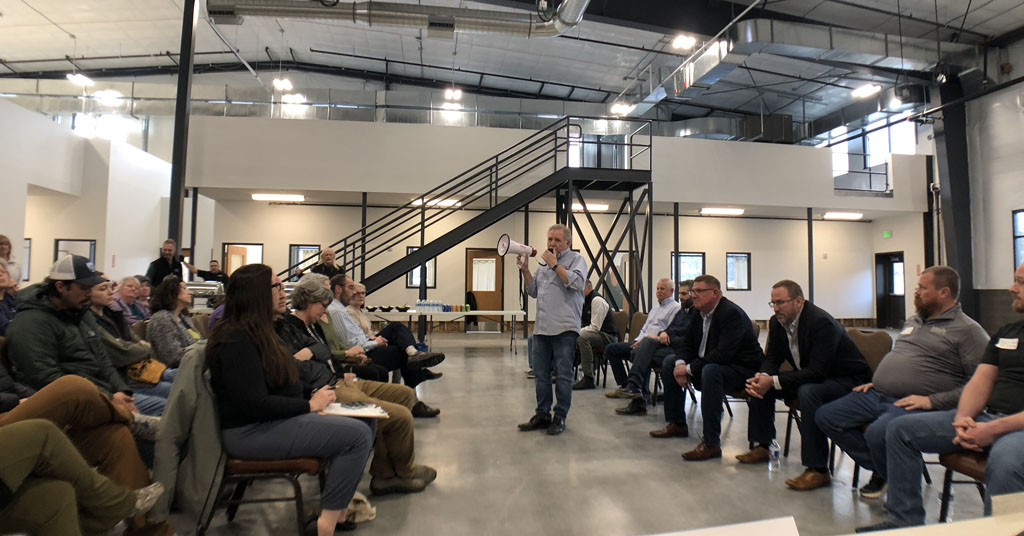
Stating the case: Stephen D. King explaining the proposed data center at a March 10 open house inside the Flex 6 building. Photo: Nathan Gilles
Lorang says he thinks it’s “unlikely” that King will find the financing to complete the data center.
“At this point [the data center is] not moving forward,” says Lorang. “I think his [King’s] history may give people some concerns about loaning him [King] the money.”
However, Lorang says he’s still concerned that the deal might be approved by the Port only to have the project stall or fail.
“The more information that we got, that only further confirmed my fears in his [King’s] ability to pull this off,” says Lorang. “I don’t want somebody to get something half done and then bail out.”
Fallon was even more critical.
“Again, the whole thing is a gamble. And I don’t gamble with other people’s lives and money. I just don’t,” says Fallon.
Whether the deal with Roundhouse goes through or not could come down to the leadership of Port President Jess Groves, who is the subject of an ongoing effort to have him recalled by voters.
Groves was “unavailable” for an interview with Columbia Insight, but agreed to answer questions in writing, according to an email sent by Jeremiah Blue, the Port’s interim general manager.
Groves has not yet replied to our questions.
The post Data center on Columbia River would nearly double town’s energy consumption appeared first on Columbia Insight.
Data center on Columbia River would nearly double town’s energy consumption was first posted on May 9, 2023 at 11:06 am.
©2022 Based in Hood River, Oregon, Columbia Insight’s mission is to publish original, balanced journalism about environmental issues affecting the Pacific Northwest. Columbia Insight is a fully independent, registered nonprofit organization. To support environmental journalism “donate here” to Columbia Insight.
Scientists begin to unravel global role of atmospheric dust in nourishing oceans
By Sean Nealon, 541-737-0787, sean.nealon@oregonstate.edu Source: Toby Westberry, 541-737-5274, toby.westberry@oregonstate.edu This news release is available online: https://beav.es/SKb Photos: https://flic.kr/s/aHBqjABDee CORVALLIS, Ore. – New research led by an Oregon State University scientist begins to unravel the role dust plays in nourishing global ocean ecosystems while helping regulate atmospheric carbon dioxide levels. Researchers have long known that phytoplankton – plantlike organisms that […]
The post Scientists begin to unravel global role of atmospheric dust in nourishing oceans appeared first on Highway 58 Herald.
As climate change intensifies, organizations are scaling up by joining forces
Accustomed to working in silos, land trusts are realizing fractured efforts to save the environment won’t cut it
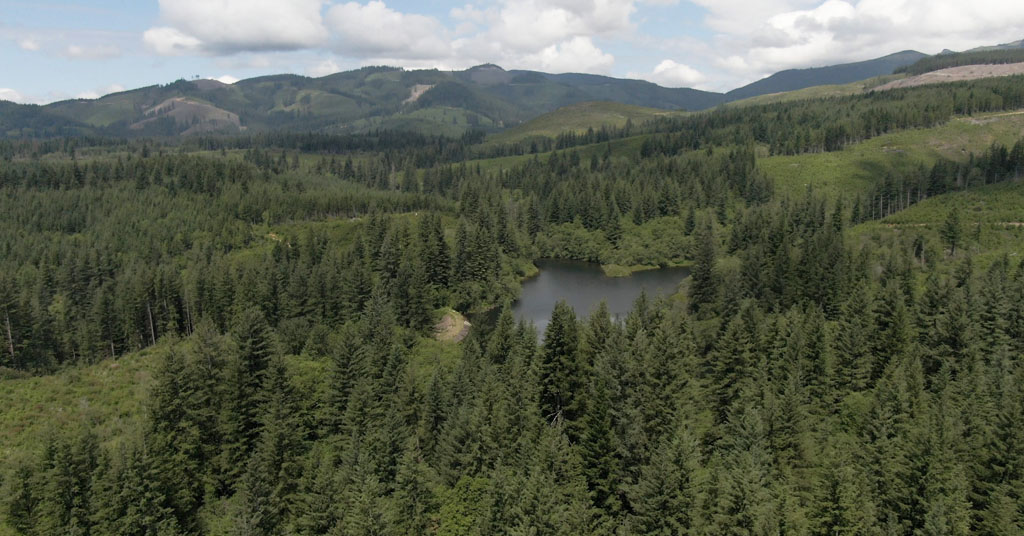
Going extinct: Formed by Kwoneesum Dam, the 10-acre Kwoneesum Lake in southwest Washington blocks fish from spawning habitat. Thanks to a collaborative effort, it will be removed next year. Photo: Resources Legacy Fund
By Grant Stringer, May 4, 2023. For almost 60 years, a dam tucked into a creek on private timberland in southwest Washington has cut off miles of habitat for endangered salmon and steelhead.
The dam will be demolished next year and the surrounding ecosystem restored thanks an unlikely alliance of East Coast philanthropists, a timber giant, tribal scientists and a budding network of conservation-minded land trusts.
The removal of Kwoneesum Dam, which stands northeast of Camas, Wash., is part of a major trend in conservation being led in the Columbia River Basin.
Here, Pacific Northwest land trusts are collaborating with new partners to shore up climate resilience throughout the region.
Scientists say areas that can weather the worst of climate change, such as protected watersheds and mature forests, will become critical to biodiversity and human communities.
Local land trusts have banded together and made it their mission to protect—and connect—these areas.
In doing so, they’re attempting something new: aligning climate action on a regional scale.
“There’s something way, way bigger going on with this,” says Dan Bell, land trust director at the nonprofit Friends of the Columbia Gorge, of the recent moves to join forces and consolidate resources in the fight against climate change.
Fractured efforts
In 2019, Columbia Land Trust, based in Vancouver, Wash., bought Kwoneesum Dam and a surrounding 1,300-acre parcel for about $3.24 million from Weyerhaeuser, the Seattle timber company. Co-funders included the Washington state government and the national Land Trust Alliance, based in Wash. D.C.
Columbia Land Trust and the Land Trust Alliance are part of a regional network of trusts calling itself the Pacific Northwest Resilient Landscapes Initiative, which announced its first projects to conserve essential lands in 2020.
Together, they’ve identified and helped protect about two dozen areas in the Northwest, from coastal rainforests to Oregon’s high desert.

Blocking motion: Kwoneesum Dam is a 45-foot-high earthen structure on Wildboy Creek, which flows into the lower Washougal River, a tributary of the Columbia River. Photo: Resources Legacy Fund
These lands provide critical sources of water, diverse ecosystems, connected habitats and fire-resilient forests. In some cases, they’re also managed to allow for some timber production and ranching to support people as well, says Owen Wozniak, a Land Trust Alliance project manager who steers the initiative.
To pick which lands to protect, they’re using a scientific tool developed by the Nature Conservancy that maps resilient lands throughout the United States.
Friends of the Columbia Gorge also used the map when charting about 30 resilient areas in the Columbia River Gorge. The Gorge Commission’s new draft climate plan prioritizes these lands for conservation.
Bell says its another example of collaboration for resilience, which bucks the tendency of nonprofits and Gorge governments to work on separate climate plans, in silos.
“To some degree, that fracturing is very real,” says Bell.
Wozniak says the nature of climate change requires regional cooperation between groups like land trusts. For instance, salmon and other fish migrating through the Columbia River Basin are deeply threatened by a combination of dams in three states, climate-fueled heatwaves and low streamflows.
Land trusts are tackling massive issues like these “by working at a scale that somewhat makes more sense,” he says.
‘Great experiment’ in conservation
The project around Kwoneesum Dam is a case study in conservation for climate resilience, says Cherie Kearney, conservation director at Columbia Land Trust.
The dam has served no purpose since the 1980s, when the first in a line of wood products companies bought it and the surrounding land. Fish have no way to navigate over the dam. Cowlitz Indian Tribe scientists plan to begin removing the dam next year.
The area now functions as a bridge between state-owned lands amid a patchwork of timber farms in southwest Washington’s Cascades foothills.
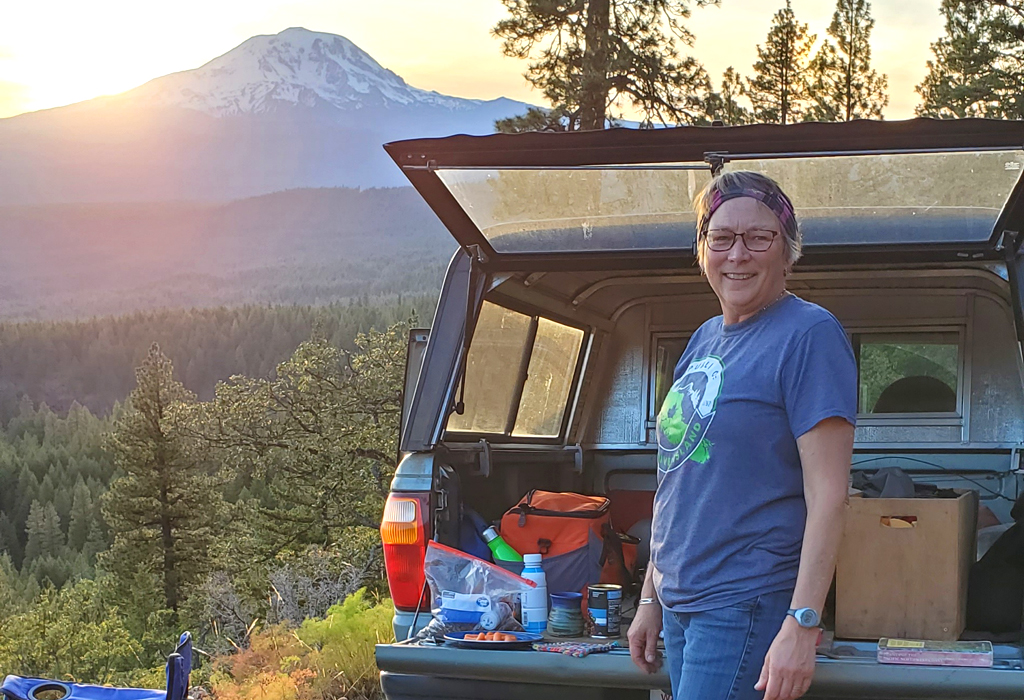
Peak partner: Cherie Kearney specializes in bringing stakeholders together. Photo: Columbia Land Trust
Kearney and her team will manage the land for sustainability by keeping mature trees from being logged and helping the Cowlitz Indian Tribe protect the riparian ecosystem.
The Pacific Northwest Resilient Landscapes Initiative doled out about $70,000 for the project and helped pay for two others spearheaded by Columbia Land Trust in Washington.
These include almost 5,000 acres along the Klickitat River in the central part of the state now conserved in partnership with the Yakama Nation.
The initiative has helped protect about 20 other resilient areas in the region, including a 32-square-mile corridor in Oregon’s coastal rainforest; a desert expanse in the state’s southwest corner; an island of private land in Idaho’s Caribou-Targhee National Forest at risk of development; and a mosaic of habitats in central Washington.
It’s a “great experiment” in conservation, says Wozniak.
He says the work hinges on a thriving ecosystem of land trusts in the Pacific Northwest that’s probably the strongest of any region in the United States.
Focus on ‘resilient lands’
Wozniak and Bell are both thrilled with the Nature Conservancy’s mapping tool that estimates the resilience of U.S. lands on a granular level.
That map is the backbone of the Gorge Commission’s key, 2035 goal to conserve 70% of “above average” resilient lands in the Columbia River Gorge National Scenic Area spanning Oregon and Washington.

Transactions manager: Owen Wozniak. Photo: Land Trust Alliance
The plans are detailed in the commission’s draft climate plan alongside measures to slash greenhouse gas emissions.
About 63% of these resilient areas are already conserved, according to the draft plan.
The 32 areas include river deltas, the Gorge’s many creeks and peaks from The Dalles to Dog Mountain.
Bell says he’s pleased with the plans.
He also applauds the commission for bringing a wide variety of people and groups to the table in developing the plans, including Friends of the Gorge.
“Collaboration is key,” he says.
Not just key, it appears, but increasingly common. And vital.
Columbia Insight’s reporting on biodiversity in the Columbia River Gorge is supported by the Autzen Foundation and Pacific Power Foundation.

The post As climate change intensifies, organizations are scaling up by joining forces appeared first on Columbia Insight.
As climate change intensifies, organizations are scaling up by joining forces was first posted on May 4, 2023 at 8:05 am.
©2022 Based in Hood River, Oregon, Columbia Insight’s mission is to publish original, balanced journalism about environmental issues affecting the Pacific Northwest. Columbia Insight is a fully independent, registered nonprofit organization. To support environmental journalism “donate here” to Columbia Insight.
Following Native American rituals, hoping to put youthful offenders on a straight path
Secretary of State Shemia Fagan resigns amid moonlighting scandal
By PETER WONG and GARY A. WARNER Oregon Capital Bureau Oregon Secretary of State Shemia Fagan has resigned effective May 8, a major turn in a moonlighting scandal that broke out just last week. Fagan issued an announcement that she will leave office next week, with her staff reporting to deputy Cheryl Myers on an […]
The post Secretary of State Shemia Fagan resigns amid moonlighting scandal appeared first on Highway 58 Herald.